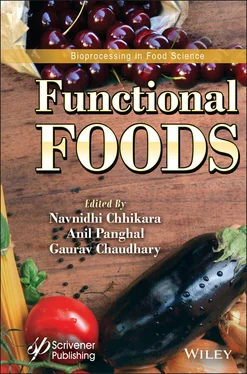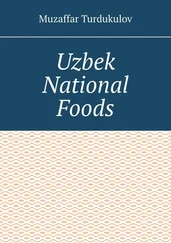Functional Foods
Здесь есть возможность читать онлайн «Functional Foods» — ознакомительный отрывок электронной книги совершенно бесплатно, а после прочтения отрывка купить полную версию. В некоторых случаях можно слушать аудио, скачать через торрент в формате fb2 и присутствует краткое содержание. Жанр: unrecognised, на английском языке. Описание произведения, (предисловие) а так же отзывы посетителей доступны на портале библиотеки ЛибКат.
- Название:Functional Foods
- Автор:
- Жанр:
- Год:неизвестен
- ISBN:нет данных
- Рейтинг книги:3 / 5. Голосов: 1
-
Избранное:Добавить в избранное
- Отзывы:
-
Ваша оценка:
- 60
- 1
- 2
- 3
- 4
- 5
Functional Foods: краткое содержание, описание и аннотация
Предлагаем к чтению аннотацию, описание, краткое содержание или предисловие (зависит от того, что написал сам автор книги «Functional Foods»). Если вы не нашли необходимую информацию о книге — напишите в комментариях, мы постараемся отыскать её.
Presenting cutting-edge information on new and emerging food engineering processes,
, the second volume in the groundbreaking new series, “Bioprocessing in Food Science,” is an essential reference on the modeling, quality, safety, and technologies associated with food processing operations today.
This outstanding new volume:
Audience: Functional Foods
Functional Foods — читать онлайн ознакомительный отрывок
Ниже представлен текст книги, разбитый по страницам. Система сохранения места последней прочитанной страницы, позволяет с удобством читать онлайн бесплатно книгу «Functional Foods», без необходимости каждый раз заново искать на чём Вы остановились. Поставьте закладку, и сможете в любой момент перейти на страницу, на которой закончили чтение.
Интервал:
Закладка:
73. Fraeye I., Bruneel C., Lemahieu C., Buyse J., Muylaert K., Foubert I. Dietary enrichment of eggs with omega-3 fatty acids: A review. Food Res. Int . 2012;48:961–969.
74. Kassis N., Drake S.R., Beamer S.K., Matak K.E., Jaczynski J. Development of nutraceutical egg products with omega-3-rich oils. LWT-Food Sci. Techol . 2010;43:777–783. doi: 10.1016/j.lwt.2009.12.014.
75. Arias-Rico, J., Cerón-Sandoval, M. I., Sandoval-Gallegos, E. M., Ramírez-Moreno, E., Fernández-Cortés, T. L., Jaimez-Ordaz, J., ... & Añorve-Morga, J. (2018). Evaluation of consumption of poultry products enriched with omega-3 fatty acids in anthropometric, biochemical, and cardiovascular parameters. Journal of Food Quality, 2018 . Article ID 9620104
76. Blades M. Functional foods or Nutraceuticals. Nutr. Food Sci . 30: 73-75 (2000).
77. Lewis, N. M., Seburg, S., & Flanagan, N. L. (2000). Enriched eggs as a source of n-3 polyunsaturated fatty acids for humans. Poultry Science, 79(7) , 971-974.
78. Nocella, G., & Kennedy, O. (2012). Food health claims–What consumers understand. Food Policy , 37 (5), 571-580.
79. Moriyama, H., Ikeda, H., & Bagchi, D. (2019). Foods with function claims emerging from the framework of so-called health foods. In Nutraceutical and Functional Food Regulations in the United States and around the World (pp. 377-385). Academic Press.
80. Iwatani, S., & Yamamoto, N. (2019). Functional food products in Japan: A review. Food Science and Human Wellness , 8 (2), 96-101.
1 *Corresponding author: anilpanghal@gmail.com
2
Prebiotics and Synbiotics in Functional Foods
Cássia P. Barros1, Ramon Silva1,2, Jonas T. Guimarães1, Celso F. Balhtazar1, Silvani Verruck3, Tatiana C. Pimentel4, Erick A. Esmerino1, Mônica Q. Freitas1, Maria Carmela K.H. Duarte1, Márcia Cristina Silva2 and Adriano Gomes da Cruz2*
1Fluminense Federal University (UFF), Faculty of Veterinary, Niterói, RJ, Brazil
2Federal Institute of Science and Technology of Rio de Janeiro (IFRJ), Department of Food, Rio de Janeiro, RJ, Brazil
3Federal University of Santa Catarina (UFSC), Department of Food Science and Technology, Florianópolis, Santa Catarina, Brazil
4Federal Institute of Paraná (IFPR), Campus Paranavaí, Paranavaí, PR, Brazil
Abstract
The functional food market is constantly expanding and updating, due to the consumers’ demand for foods with functional benefits and a more balanced diet. Functional foods usually are described as foods fortified with special constituents that offer some beneficial action to human health. Among the foods that have a long history of functionality are the dairy products added with prebiotics and/or synbiotics. The daily consumption of prebiotics and/or synbiotics contributes significantly to human health, as in the prevention or treatment of irritable bowel syndrome, colon cancer, obesity, type 2 diabetes, and cardiovascular diseases. In addition, there is a great market demand for innovations in functional foods. With the current definitions of prebiotics and synbiotics updated and clarified (approaching two different categories of synbiotics, the complementary and the synergistic synbiotic), it became much easier for the industry and researchers to explore and create new prebiotics/synbiotics products. In this sense, recently, it was observed an increased quantity of scientific studies using prebiotics or synbiotics ingredients with prospective health claims in dairy products. This chapter will present the main updates on prebiotic and synbiotic dairy products and their health benefits.
Keywords:Functional foods, prebiotics, synbiotics, health benefits
2.1 Introduction
The increasing incidence of chronic diseases related to an unbalanced diet has aroused great interest from the food industries in offering products that could reduce the risks of diseases and/or promoting health [1]. Thus, the nutritional aspect and the benefits that food can bring to health have been watched carefully by consumers. Consumers have been looking for a healthier diet because they are concerned about the relationship between food and health [2]. In this class of foods, we can highlight those with functional properties.
There is no globally accepted definition for functional foods yet [3]. The term “functional foods” was used in Japan in 1984 to describe products fortified with special constituents that offer some beneficial action to human health [3]. In this sense, several official agencies, such as the European Food Safety Authority (EFSA, European Union), the Brazilian Health Regulatory Agency (ANVISA, Brazil), and the Food and Drug Administration (FDA, United States) proposed different concepts for functional foods [4]. Therefore, the products developed must respect the criteria of each of these agencies individually to be marketed, such as being validated by human intervention trials [4]. Nowadays, some of the functional ingredients more used by the industry are carotenoids, chlorophylls, fibers, organosulfur compounds, phytosterols, polyphenols, probiotics, prebiotics, and synbiotics [4]. Table 2.1shows the potential beneficial effects of ingredients and functional compounds on human health.
The functionality of a food can be associated with the addition of a functional compound/ingredient, but can also be associated with the elimination or replacement of dietary components considered “unhealthy”, such as sugar, salt, and fat [3]. The market for functional foods is extensive and includes several types of food (dairy, vegetables, meat, baked goods, beverages, etc.). This market has the prospect of reaching $ 275.77 billion in 2025 [5]. The dairy sector stands out in this sector representing about 40% of the functional foods in the market [6]. Fermented dairy products (yogurts and fermented milk) are the majority of functional dairy products in the market, most of them added with the functional ingredients probiotics, prebiotics and/or synbiotics [6]. These products were the first dairy products commercialized with a functional claim and still dominate the functional beverage market [7]. In addition to dairy products, prebiotics may be used in several kinds food products, such as health drinks and beverages, meat products, infant formula, as well as supplements and animal feeds [8].
Table 2.1 Potential beneficial effects of ingredients and functional compounds on human health. Adapted from Granato et al . [4].
| Functional compound or ingredient | Health benefits | |
| Carotenoids | β-Carotene | Antioxidant, reduces the risk of diseases in eyes, provitamin A, antimutagenic, and radioprotective, etc. |
| Lutein | Antioxidant, antiatherogenic, anti-inflammatory, antidiabetic, antihypertensive, reduction of risk of cancer, antiulcer, reduces the risk of diseases in eyes. | |
| Lycopene | Antioxidant, cardiovascular disease reduction, cancer risk reduction | |
| Zeaxanthin | Antioxidant, anti-inflammatory, provitamin A, better cognitive function, cardiovascular disease reduction, reduction of risk of cancer. | |
| Curcumin | Antioxidant, reduction of diabetes mellitus risk, neurological disorder reduction, cardiovascular disease reduction, and inflammatory mediator reduction. | |
| Chlorophylls | Chlorophyll A and B | Antioxidant, decrease in cancer risk. |
| Fibers | β-Glucan | Cardiovascular disease reduction, controls diabetes, stimulates the immune system. |
| Inulin | Prebiotic effect, reduction of atherosclerosis, improve the satiety. | |
| Organosulfur compounds | Glucosinolates | Reduction of risk of metastasis and cancer, avoid redox imbalance in the cells, reduce inflammatory chronic diseases. |
| Isothiocyanates | Reduction of neurological disorder and reduction of cancer risk. | |
| Phytosterols | Sterol and stanol | Reduction of total cholesterol and LDL-C (total cholesterol), anti-inflammatory, and reduction of neurological disorder |
| Polyphenols | Anthocyanins, Proanthocyanidins | Antioxidant, prevent and treat hyperuricemia and/or gout, and reduce cardiovascular disease. |
| Isoflavones | Decrease the risk of cardiovascular disease, reduce the LDL-C, reduce osteoporosis, reduction of diabetes mellitus risk, and reduce liver disease. | |
| Lignans | Reduce the risk of cardiovascular disease and hormonal cancer. | |
| Resveratrol | Reduction of cardiovascular disease, reduction of LDL-C | |
| Prebiotics | Inulin, fructooligosaccharides, xylooligosaccharides | Diminution of symptoms of depression, reduction of atherosclerosis, improve satiety, and bifidogenic effect. |
| Probiotics | Lacticaseibacillus casei, Lactobacillus acidophilus, Bifidobacterium lactis | Management of the gut microbiota, reduction in the gain of weight, reduction of waist circumference, reduction of glucose in the serum, reduction of homeostatic model assessment–insulin resistance (HOMA-IR) and insulin, reduction of LDL-C, increase of glutathione levels in the blood, reduction of products of oxidation in blood, reduction of markers of inflammation, reduction of hypertension, reduction of hyperglycemia, increase of HDL-C (high-density lipoprotein–cholesterol). |
| Synbiotics | L. casei , B. lactis plus inulin, L. acidophilus , fructooligosaccharides, xylooligosaccharides | Reduction of inflammation markers, increase of total antioxidant capacity in serum and plasma, increase of levels of glutathione in blood, increase in nitric oxide, reduction of infection risk, reduction of hypertension, reduction of hyperglycemia. |
Prebiotics were first defined as non-digestible food ingredients which selectively stimulate the growth of a restricted type of bacteria in the large intestine, benefiting the host [9]. Currently, prebiotic is defined as “a substrate that is selectively utilized by host microorganisms conferring health benefits” [10]. According to these experts, non-digestible carbohydrates (oligosaccharides and polysaccharides), some peptides and proteins, phenolic compounds, and certain lipids (esters) can also be considered prebiotic ingredients according to the new definition. Thus, when prebiotics are selectively fermented by the resident microbiota the fermentation results in compounds responsible to enhance the physiological properties of the host, such as mineral absorption, intestinal function, decreased risk of colon cancer, and regulation of glucose and lipid metabolism [4, 10]. In addition, they are associated with the prevention of diet-related diseases, such as hypercholesterolemia, diabetes, gastrointestinal infections and intestinal inflammation [11]. The prebiotics consumption also encourages the development of beneficial bacteria and difficult harmful bacteria establishment in the body, which cooperate for the prevention of infections and allergies [12, 13]. The prebiotic market is growing from 2016 to 2024 at an 8% CAGR (Compound Annual Growth Rate), prospecting 989.4 kilotons in 2021 [14].
Читать дальшеИнтервал:
Закладка:
Похожие книги на «Functional Foods»
Представляем Вашему вниманию похожие книги на «Functional Foods» списком для выбора. Мы отобрали схожую по названию и смыслу литературу в надежде предоставить читателям больше вариантов отыскать новые, интересные, ещё непрочитанные произведения.
Обсуждение, отзывы о книге «Functional Foods» и просто собственные мнения читателей. Оставьте ваши комментарии, напишите, что Вы думаете о произведении, его смысле или главных героях. Укажите что конкретно понравилось, а что нет, и почему Вы так считаете.










